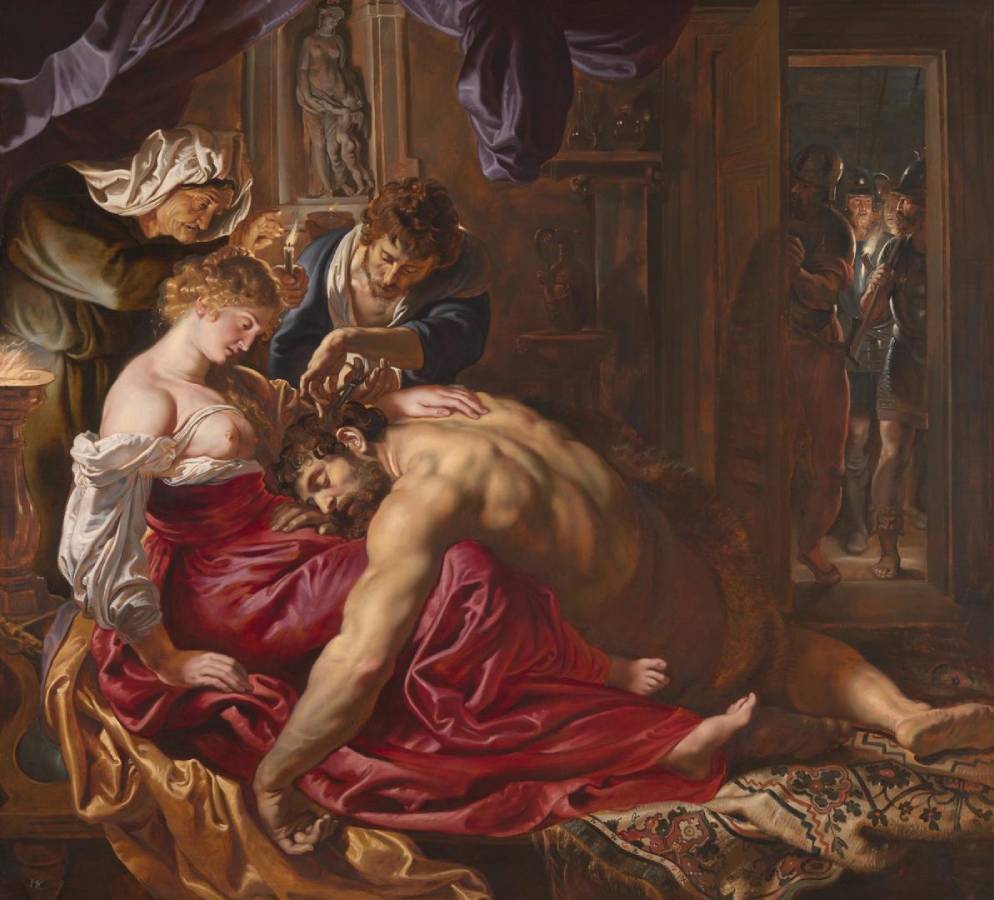Rubens, Peter Paul (1577-1640)
Samson and Delilah
c.1609–1610
Oil on wood, 185 × 205 cm
National Gallery, London
Peter Paul Rubens’s Samson and Delilah portrays a tragedy of love and betrayal. According to the Old Testament, Samson, a Jewish hero blessed with superhuman strength, killed a thousand Philistine soldiers with the jawbone of a donkey. The Philistine leaders wanted revenge. They bribed Delilah, the woman Samson loved, to discover the source of his strength. After several attempts she persuaded him to tell her his secret: his God-given strength lay in his hair, uncut since he was born.
In Rubens’s picture, Samson lies in Delilah’s lap, his dark head resting on the deep crimson of her robe, his powerful body seeming vulnerable in sleep. Delilah’s dishevelled dress, her loosened hair and exposed breasts suggest a sleep after making love. She sits motionless, her face beautiful but almost inscrutable while her accomplice snips away at Samson’s hair. Perhaps it’s possible to read a trace of triumph or pity – or both – as she gazes down at Samson, but only her hand placed gently on his shoulder lets slip a whisper of regret. In radiant pools of light, her soft flesh glows, her golden hair brushes her shoulder and luxuriant textures surround her; all evoke the sensuality of the love now lost. Just one flaring torch illuminates the soldiers waiting outside to capture Samson.
But perhaps Delilah will pay for her treachery. Rubens carefully placed an old woman directly behind her, and mirrored their two profiles. The old woman’s is withered but bears a striking likeness to Delilah’s, perhaps suggesting – in the manner of a vanitas – that she will one day lose the beauty that was Samson’s downfall. Similar old women are sometimes portrayed as brothel keepers in moralising paintings of the time, but we don’t know if this was Rubens’s intention. In the Old Testament there’s no suggestion that Delilah had any such connection – rather that this was a love affair, making her betrayal even more cruel.
Moreover, in the act of treachery itself, Rubens follows the Old Testament description absolutely accurately: Delilah doesn‘t cut Samson’s hair, but gets a man to do it for her. Some have suggested that Rubens chose to show the man’s hands crossed in a position sometimes thought to be symbolic of treachery. It seems more likely that he was demonstrating his skill at painting the hands performing such a delicate action – accurately placed for cutting the curl at that angle and without waking the sleeping man. He also echoed the position of the accomplice’s left hand in Samson’s own, but Samson’s is relaxed rather than in a state of tension.
Rubens painted Samson and Delilah on his return from Italy for the private collection of his friend and patron, Nicolaas II Rockox, the mayor of Antwerp; the theme was popular in the Southern Netherlands at the time. The picture was designed to hang above the mantelpiece of Rockox’s large town house and Rubens chose rich, strongly contrasting colours to contend with the brilliance of the flickering flames of the fire. Rockox was an antiquarian with a large collection of Roman and other classical artefacts. For this reason, perhaps, Rubens included objects that – while not authentic – perhaps give the atmosphere of ancient Rome: the brazier blazing beside Delilah and the tripod it stands on, her bed with the horses’ heads, and the ewer high up on the wall beside it.
Above all – and a true borrowing from antiquity – is the sculpture in the wall niche above the group in the background. Venus, the Roman goddess of love and beauty, stands looking down on the scene with her son, Cupid, god of erotic love. He clings to her, his head raised towards her as if asking a question: why this end to love? Although Venus doesn‘t wear her traditional girdle, said to make her irresistible to anyone she chose to seduce, Rubens has given Delilah such a band over her breasts, adding to her voluptuousness – and implying that she too could not be denied.
While in Rome, Rubens had seen the work of Michelangelo and sculptures such as the Farnese Hercules and the Belvedere Torso, from which he made drawings. These gave him the basis for the musculature of his sleeping Samson. He looked more specifically to Michelangelo for Delilah’s pose – to his sculpture of Night on the left of the sarcophagus of the tomb of Lorenzo de Medici in Florence and to his painting of Leda and the swan (a copy of which is in the National Gallery’s collection). But while the resemblance to the pose is strong, Rubens gave his Delilah more sensual grace, femininity and subtle expression. In Rubens’s painting, Delilah’s thighs are concealed under the swirl of the rich silk of her robe, more tactile and more subtle than Leda’s bare flesh.
Caravaggio’s experiments in chiaroscuro also had a great impact on Rubens. He came to realise how this high contrast between light and shadow conveyed powerful atmosphere and dramatic tension, and used it to the full in his great painting. Chiaroscuro, he discovered, could make flesh glow and objects reflect and shine. Shadows could build a sense of fear and dread. Even if we don’t know the story, the flickering light captures the drama of the complex group where Samson’s hair is being cut, with every eye focused on that curl. And just the single flare of a torch on the glittering eyes of the soldiers waiting in the dark, pushes the tension to the extreme. (NG)
